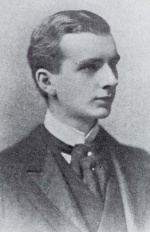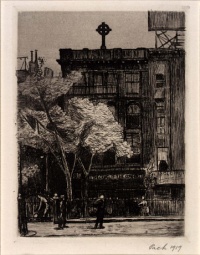Ernest Temple Hargrove
Ernest Temple Hargrove was an English barrister best known as the leader of a group of Theosophists based in New York who broke away from Katherine Tingley's Universal Brotherhood and Theosophical Society to form the Theosophical Society in America in 1898. This was the second of three organizations using that name. In 1908 the name was changed to "Theosophical Society."
Personal life and career
Ernest Temple Hargrove was born December 17, 1870 in Brentford in the west portion of London, England.[1] He arrived in New York on April 10, 1892, and on October 17, 1900 became a naturalized citizen of the United States.[2] In London he had been a barrister, but in the United States became a journalist and writer. While in New York, he became acquainted with many Theosophists, including the family of E. A. Neresheimer. Neresheimer's daughter Aimée (or Amy) was married to Ernest on January 17, 1899 in New York.[3] Subsequently, the Neresheimers, Ernest and Aimée moved to Colorado. Ernest and Aimée had a son, William, born in 1902, and a daughter Joan, born in 1905. By 1910, though, the couple had divorced and Aimée was married to Denver lawyer Milton Smith.[4] She died in Houston, Texas.
Theosophical Society involvement
In New York, young Hargrove became acquainted with William Quan Judge and other Theosophists. On October 30, 1891 Hargrove was admitted to membership of the Theosophical Society.[5]
During the last year of Judge's life [1895], Hargrove worked as his secretary. This was a difficult time, when Mr. Judge was was mounting a defense against accusations by international Theosophical Society leaders Henry Steel Olcott and Annie Besant. Judge's health was declining, as he suffered from lingering effects of Chagas disease contracted in Venezuela. That year, Hargrove gave lectures in a tour of several cities:
On December 22d Mr. Hargrove addressed over 600 people in the Academy of Music at Macon, Ga. Considering the comparatively small population of this city, such a gathering spoke volumes for the work of the local branch. Washington was reached on January 7th, a lecture being given that evening. Another on the 9th was attended by about 200 people and was well reported in the newspapers. [6]
He continued for the next nine days in Pittsburgh, Wilkinsburg, and Philadelphia before his return to New York.
Establishing Theosophical Society in America
A book of notable New Yorkers from 1899 listed Hargrove as a clergyman, ex-president of the "Theosophical Society in America and Europe," and former editor of Theosophy.[7]
Later years
After his divorce from Aimée, Hargrove did not remarry. Census records from 1910 list him as single, with the occupation of priest in a church.[8] His residence was Chapel Farm, Riverdale-on-Hudson, in the Bronx. He served at the Episcopalian Chapel of the Comforter, where fellow Theosophists Clement Acton Griscom, Jr. and Henry Bedinger Mitchell were members, and where the funeral service for Charles Johnston was held in 1931. In addition to his priestly duties, Hargrove was president of the Griscom-Russell Co. and Jas. Reilly Repair & Supply Co., Riverdale-on-Hudson.[9]
After Hargrove died on April 8, 1939, his own service took place at the Chapel of the Comforter.
Writings
Hargrove wrote numerous articles and edited the periodical Theosophy during the years 1896-1897. Under the initials ETH he wrote 29 articles, and there are another 28 under Hargrove. As editor of Theosophy he undoubtedly wrote numerous other articles that were not signed. He was also known to have used noms de plume such as Chew-Yew-Chang or Che-Yew Tsang.
He also worked for a journalist for other non-Theosophical periodicals and wrote books:
- World Politics. New York: R.F. Fenno & Co., 1898 and London: Sampson Low, Marston & Co., 1898. 220 pages. Available at Hathitrust and Internet Archive.
- An American view of the South African situation: How Australasia might help Great Britain. New York: 1901. 64 pages. Available at Google Books.
- Life's Questions.
- Some Modern Failings.
Additional resources
- Page xii of Supplement to The Theosophist Volume XXII (December, 1900) has a few (unflattering) paragraphs about Hargrove as a journalist associated with the South Africa News, published in Cape Town.
Notes
- ↑ England and Wales FreeBMD Birth Index, 1837-1915.
- ↑ U. S. Immigration Records. New York District Court. 1910.
- ↑ New York Marriage Index, 1866-1937.
- ↑ 1910 U. S. Census.
- ↑ Theosophical Society General Membership Register, 1875-1942 at http://tsmembers.org/. See book 1, entry 7613 (website file: 1C/42).
- ↑ Anonymous, "Movements of E. T. Hargrove" The Theosophical Forum 10 (February, 1896): 160.
- ↑ Moses King, Notable New Yorkers of 1896-1899: a companion volume to King's handbook of New York City. New York: M. King, 1899.
- ↑ U. S. Census, 1910.
- ↑ New York city directory, 1925.

